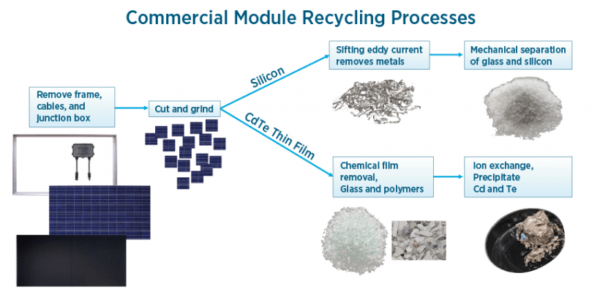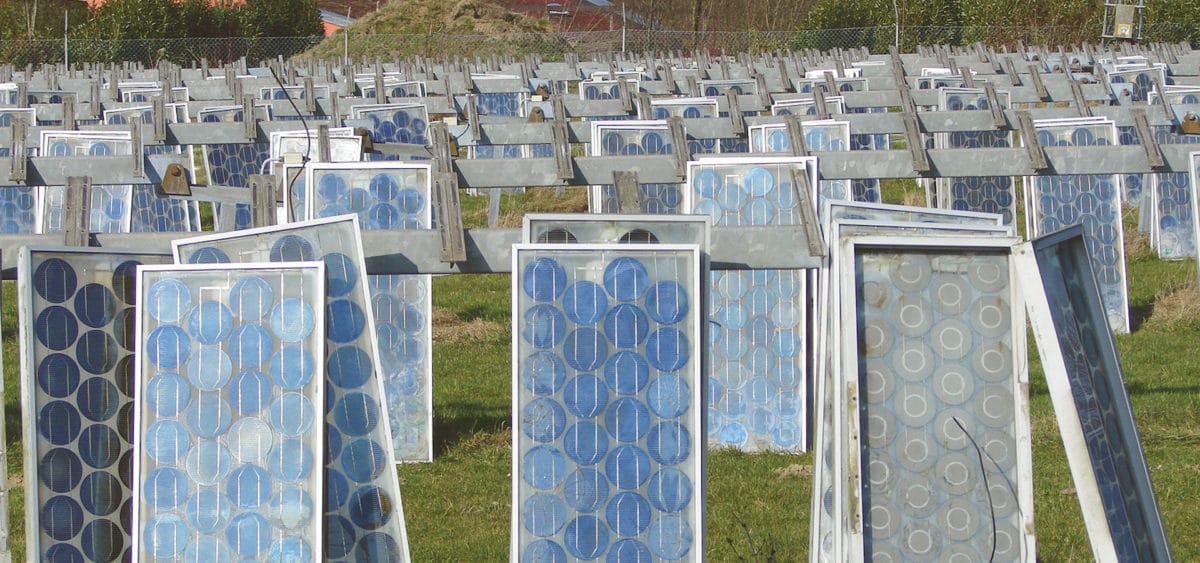The US Department of Energy (DOE) today released an action plan to enable the safe and responsible handling of solar photovoltaic (PV) end-of-life (EOL) materials. In order for solar to truly be a “clean” technology, it is imperative to have a plan for disposal of solar panels at the end of their useful life. The current lifetime for solar panels is about 30 years, and while the solar industry grew slowly for several decades, about 70% of existing solar energy systems were deployed within the last five years.
The International Renewable Energy Agency forecasts that the cumulative end-of-life waste from PV in the US in 2030 is projected to be between 0.17 and 1 million tons. For perspective, there are 200 million tons of solid waste, excluding recycled and composted materials, generated in the United States each year.
Although 95% of a cadmium telluride (CdTe) and silicon (Si) solar module is recyclable, the current cost to recycle solar modules is around $15-$45 per module, while the landfill fee is $1-$5 per module, not including transportation costs. Recycling processes that have been developed in the US for CdTe and Si solar modules also cost more than the value of materials obtained from recycling.

DOE SETO
“As we accelerate deployment of photovoltaic systems, we must also recognize the pressing need to address end-of-life for the materials in a sustainable way,” said Kelly Speakes-Backman, Principal Deputy Assistant Secretary for the Office of Energy Efficiency and Renewable Energy at the US Department of Energy.
The DOE Solar Energy Technologies Office (SETO) is funding research to improve the performance, lower the cost, and support widespread deployment of solar. Research areas that SETO will focus on include reliability and durability to increase the operating life of solar PV systems, lowering the resource-intensity of manufacturing, improving solar module recycling processes, and understanding environmental and health impacts of the EOL options. In addition, SETO will support research on how to cut the cost of module recycling by more than half by 2030. Overall, the plan is to reduce the environmental impact of solar energy while supporting the Biden Administration’s goal to decarbonize the electricity grid by 2035.
This content is protected by copyright and may not be reused. If you want to cooperate with us and would like to reuse some of our content, please contact: editors@pv-magazine.com.









I wonder why CD TE and C SI cost of recylabilty is cliumped together as I think CD TE is far lower in cost than C Si kind.. Are you withdrawing this imporant comparsion so to protect C SI from competition ?
The very significant decommissioning costs of nuclear plants, and the essentially perpetual costs of caring for spent nuclear fuel, are embedded in utility rates. Perhaps establishing state/federal sinking funds for recycling utility-scale PV is more challenging because it requires engagement with every owning utility and corporate enterprise. But amortizatizing recycle costs within PPAs and rates is not rocket science.
I feel at the 30 yr mark panels tested that still work should be re-installed on sites or sold at a great discount to consumers who cannot afford new systems.
That way panels are still useful as at 25 yrs old will still produce 75% or new panels and can continue for another 20 + yrs to provide energy to poorer community sites.